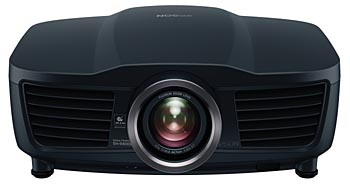Yesterday Epson flew me up to Sydney to attend at Fox Studios, well, not precisely a launch, but a briefing on its two forthcoming home theatre projectors. They will be available in November. These are somewhat of a departure for Epson. According to the industry figures it presented, it has a 53% of the total projector market in Australia, and a 34% share of the 1080p (ie. good quality home theatre) segment of the Australian projector market.
And pretty much all of these are LCD projectors. As are its two new models, but they are still very different, because instead of the LCD panels controlling the light as it passes through them, these ones use reflective LCD panels. Ah, I said, you mean LCoS! But no. Apparently they are quite different to Liquid Crystal on Silicon (which appears most prominently as DiLA by JVC, and SXRD by Sony). According to Epson’s schematic, its panels are pretty much the same as its transmissive ones through the first six layers. It is only when the light gets to the bottom electrode that things are different. Instead of a transparent electrode, a reflective aluminium one is used, sending the light back the way it came.
There are several advantages to this, most obviously a reduced screen door effect since the wiring and the active parts can be behind the reflective electrode, instead of being squeezed into gaps between the transparent parts.
But Epson says that it has other advantages. In particular, it is able to produce significantly deeper blacks. Apparently the light is first polarised, but the passage through the layers making up the LCD panel scatters the polarisation to some extent, inconsistently depending on the angle at which the light makes its passage.
By travelling through the same layers in both directions, the de-polarisation is considerably more consistent for the different angles, and so can be corrected. That then allows the light to be more effectively blocked by a polarisation filter.
The net effect is a significant boost of the native contrast ratio of the reflective panel (RHTPS Epson calls it) compared to the transmissive one (HTPS). The native contrast ratio of Epson’s current top of the line model is about 6,000:1. This is pretty impressive, in 2002 the best that LCD projectors could manage was about 600:1.
The lower cost of the two new Epson projectors — the Epson EH-R2000 (prices not set yet, but probably around $AUS5,500) — offers a native aspect ratio of 25,000:1. The more expensive (same deal: ~$7,500) offers 40,000:1. With their dynamic iris operation, they claim 500,000:1 and 1,000,000:1 respectively for full on/full off.
I reckon this is pretty exciting. I’ve been using the Epson EH-TW5500 for many months on a long-term loan from the company, and I’ve thought the blacks very impressive. The $20,000+ Runco LED/DLP was a little better in that regard, but that’s about the only one. These new models should be seriously blacker.
Another cool feature: powered focus, zoom and horizontal and vertical lens shift. I’ve been neither here nor there in the past about having power on these adjustments since they are pretty much one-off settings. But these projectors include memory presets. If you use an anamorphic lens in a constant-image-height system, one of the presets can quickly make the image come out right when the lens swings into place. Having to make manual adjustments has been in the past a significant deterrent to anamorphic lens systems.
BTW, I have a copy of test copy of After.Life to give away. No box, etc. Quite an interesting little movie. First to request in comments can have it.



6 Responses to How black can Epson get?